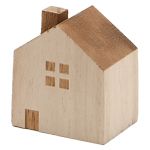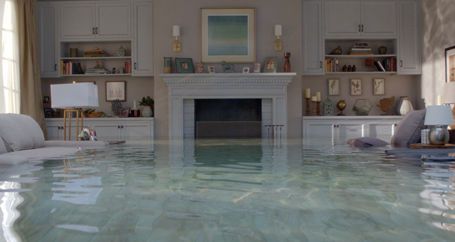Claudia and Garrett Pennington lived in a typical suburban home — 1,500 square feet, three bedrooms, two stories and a sprawling lawn — in Lancaster County, Pennsylvania.
But they never really used the third bedroom. Or their second bathroom. Or even the dining room, for that matter.
They didn’t need all that space — so why were they paying for it? “Initially, the motivation to downsize was purely financial,” says Claudia, who runs a marketing company with her husband. But then the Penningtons considered other benefits. “We realized it would also mean less space, less stuff and less stuff to maintain. It became a psychological decision, as well.” When the mix of potential benefits proved irresistible, they took a huge leap into the unknown: tiny house living.
They knew they’d have to jettison most of their possessions. But there were plenty of surprises after they lost 1,000 square feet of living space. They’ve changed the way they cook and wash clothes, for instance — and they’ve acquired other unexpected skills since moving into their tiny house.
What did they learn along the way? A lot.

To build from scratch or buy prefab
The couple’s first plan had all of the fearless optimism of a trendy, DIYer’s dream: they’d buy a lovely piece of rural property near Lancaster and — using Garrett’s mechanical engineering skills — build a cute little house.
“We started looking in the spring of 2015 and quickly realized that land was ridiculously expensive, coming in at over $100,000 for a decent lot. Plus, when we crunched the numbers and factored in construction costs for a custom-built tiny house, it would have been cheaper for us to stay in our bigger house,” says Claudia. “So that idea quickly went out the window.”

Starter Home Coverage
Includes personal service from a Farmers agent.
Both in their mid-30s, they also realized their tiny house didn’t need to be their ultimate dream home — just a sweet space for a few years. They began to explore up-and-coming neighborhoods in Lancaster. Instead of wide-open spaces, they sought out the smallest, least expensive plot of land available. Instead of a custom build, or building their own, they found that a manufactured home — as in, factory built — had everything they needed. And the price was right.

Both in their mid-30s, they also realized their tiny house didn’t need to be their ultimate dream home — just a sweet space for a few years. They began to explore up-and-coming neighborhoods in Lancaster. Instead of wide-open spaces, they sought out the smallest, least expensive plot of land available. Instead of a custom build, or building their own, they found that a manufactured home — as in, factory built — had everything they needed. And the price was right.

A custom-built home can clock in at anywhere from $100 to $400 per square foot according to Home Advisor; the average prefab home comes in at a more wallet-friendly $50 to $65 per square foot (Price ranges are estimates and vary by region, construction materials and other variables, such as delivery fees and sitework.)
“We had a fairly quick timeline, and with both of us working full-time jobs, a manufactured house seemed to be the solution. The urban neighborhood was a change for us, but we liked it. The millennials were already moving in and microbreweries and coffee shops were opening up,” Claudia says.

Just how tiny is tiny?
The next question Claudia and Garrett had to answer: how much space did they really need? They settled on 536 square feet — about the size of the average studio in New York City, but minuscule compared to the median size of a U.S. single-family home, which measures 2,426 square feet, according to 2017 figures from the U.S. Census Bureau.
Their home — about the size of four average parking spaces — was big enough for an L-shaped living room combined with a kitchen, a bathroom and a bedroom in the back.
The prefab manufacturing company they selected also allowed them to add a few touches of their own during the design phase, including moving windows to maximize natural light and make the space feel more open. “We were able to do just about anything we wanted, including reversing the floor plan, adding windows, moving windows, ceiling fans, flooring, adding a porch — you name it,” says Claudia.
The almost instant house
Depending on the size of a project, simply pouring a foundation can take several months. Because it was built on site and had to meet local building regulations, the Penningtons budgeted plenty of time for the sitework — digging, pouring concrete, adding rebar, installing electric panel — and getting approval from city inspectors.
Once the city approved their foundation, the process moved quickly. Just three weeks after a flatbed truck pulled up and off-loaded the factory-made house, it was fully installed, hooked up to utilities and move-in ready. On the big day, plenty of neighbors stopped by with welcomes — as well as quizzical looks.
“We gave a few tours,” says Claudia. “It’s so tiny compared to the 1,500-square-foot row houses next door.”

As it turned out, though, the house was just large enough for the couple, their carefully curated belongings and their two cats.
“Our own family’s initial reaction was also, ‘Wow, this is a big transition, you guys are crazy,’” Claudia recalls. “But once they saw the house they were on board. Since then, a few of them have actually said, ‘I do have too much space, I wish I could downsize.’”

Sort, sell, donate, repeat
Because Claudia and Garrett had mused about the prospect of a tiny house for years, they’d already spent some time sorting, selling and giving their belongings away. “We started downsizing our stuff years ago when we first thought we wanted to move. But the move to a smaller home meant we had to downsize way more,” recalls Claudia. The final push to declutter consumed much of the spring and summer before their new home was done.
By the time they moved, Claudia estimates that they had off-loaded 80 percent of their things — and letting go was relatively painless.
“Luckily, we didn’t have any hard-fought battles over stuff, and now neither of us even remembers what we decided to get rid of. Art was the big one for us. We had photos and prints of paintings that we just couldn’t take. The walls would be completely covered if we took everything.”
Their touchstone was communication and time. “We took our time and plenty of breaks between bouts of sorting.”
Hello, financial freedom — goodbye, bacon
For all of the planning and decluttering, there were still surprises — big ones — waiting in their new 536-square-foot reality. It only took a few days to realize how much the answer to “What’s for dinner?” would impact day-to-day living.
“When we cooked or used the oven in the big house, we didn’t notice the heat or the smell,” Claudia says. “If you cook bacon in a small house, the house heats up and smells like bacon for two days — not the end of the world but not ideal.”
Their solution: They try to not use the oven too much in the summer and instead cook outside on a charcoal grill.

Figuring out where to put essential items was a bigger challenge.
“We anticipated the cats’ litter boxes being a problem but didn’t know how to solve it until we got in there,” says Claudia. Once all the furniture was in, they realized the space they’d allocated to their washer and dryer was too small. They discussed buying a stacked set, but there was also a laundromat next door. So they decided to go without a washer and dryer for a while, and just like that, they found space for the litter boxes. The laundry hamper didn’t fit either, but under-the-bed laundry containers solved the problem.
Claudia says the key to keeping their sanity in this awkward transition was not rushing into any purchases or decisions. The couple took their time settling in and figuring out routines before finding solutions.
The unexpected upside of downsizing
After more than three years, Claudia and Garrett say they’re perfectly happy in their tiny house. And they’ve discovered some unexpected pleasures — particularly, the money they’ve saved has allowed them to indulge their love of travel.
“That’s become a bigger priority for us. Since moving, we’ve been to Portland, San Diego and Dallas,” Claudia says. “Next year we’re hoping to do a four-month tour in our teardrop trailer.”
They’ve also gained time, because their home takes so much less work to keep up. Weekends in their old home were all about housework.
“Chores like mowing the lawn — I hated that because it used to take me hours,” Claudia recalls.

Downsizing to a low-maintenance tiny house gave Claudia and Garrett the time and financial freedom to indulge in their favorite activity: traveling the country by teardrop camper.
“That’s become a bigger priority for us. Since moving, we’ve been to Portland, San Diego and Dallas,” Claudia says. “Next year we’re hoping to do a four-month tour in our teardrop trailer.”
They’ve also gained time, because their home takes so much less work to keep up. Weekends in their old home were all about housework.
“Chores like mowing the lawn — I hated that because it used to take me hours,” Claudia recalls.

Downsizing to a low-maintenance tiny house gave Claudia and Garrett the time and financial freedom to indulge in their favorite activity: traveling the country by teardrop camper.
Now, she says, “The free time has been amazing. I spend a lot more time reading now than I did before and started taking ASL (American Sign Language) tutoring in the evenings.”

Tiny isn’t for everyone
Happy as she is, Claudia says not everyone would thrive downsizing so drastically.
“It might not be for you if you’re someone with a big hobby, like you work on cars. You’d need a large garage and space,” she says. “Garrett, being an engineer, likes to work on machines and equipment and all that stuff used to live in our old garage.”
When they moved, they left all that behind. But that, too, has had an unanticipated upside. They’re now members of a local maker space that has all the equipment Garrett needs.

“It might not be for you if you’re someone with a big hobby, like you work on cars. You’d need a large garage and space,” she says. “Garrett, being an engineer, likes to work on machines and equipment and all that stuff used to live in our old garage.”
When they moved, they left all that behind. But that, too, has had an unanticipated upside. They’re now members of a local maker space that has all the equipment Garrett needs.

“One of the positive, unexpected outcomes is that we’ve gotten more involved in the community,” says Claudia. “It’s been a great way to connect with more like-minded people.” An active social life also helped ease any worries about catching cabin fever in 536 square feet. “Getting more involved is getting us out of the house.”
Custom or Prefab?
A custom-built home ranges from $100-400 per square foot, whereas the average prefab costs around $50-65 per square foot. – Home Advisor

Get a quote
Includes personal service from a Farmers agent.
Written by
The information contained in this page is provided for general informational purposes only. The information is provided by Farmers® and while we endeavor to keep the information up to date and correct, we make no representations or warranties of any kind, express or implied, about the completeness, accuracy, reliability, suitability or availability with respect to this article or the information, products, services or related graphics, if any, contained in this article for any purpose. The information is not meant as professional or expert advice, and any reliance you place on such information is therefore strictly at your own risk.
Related articles










